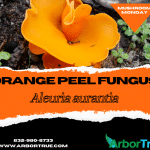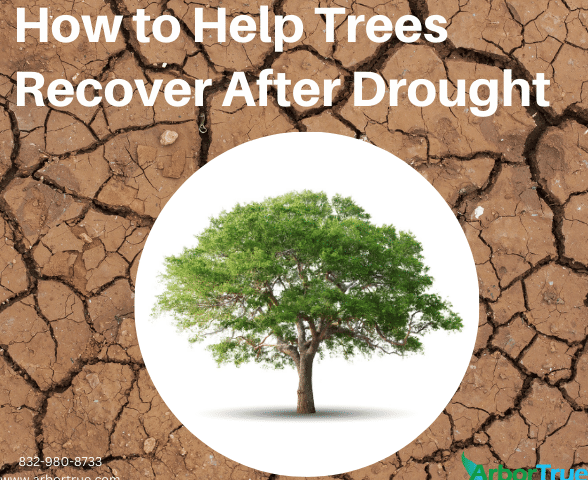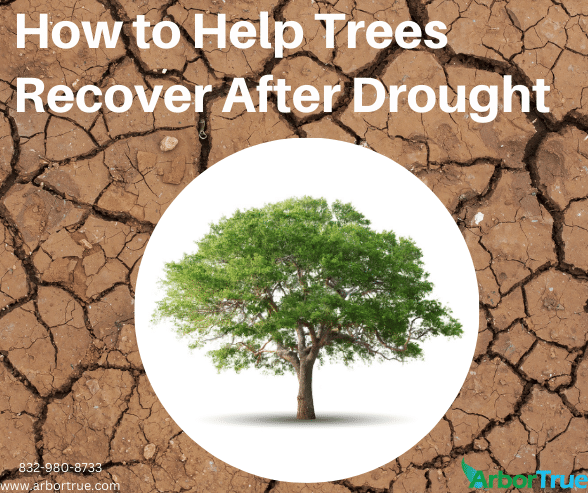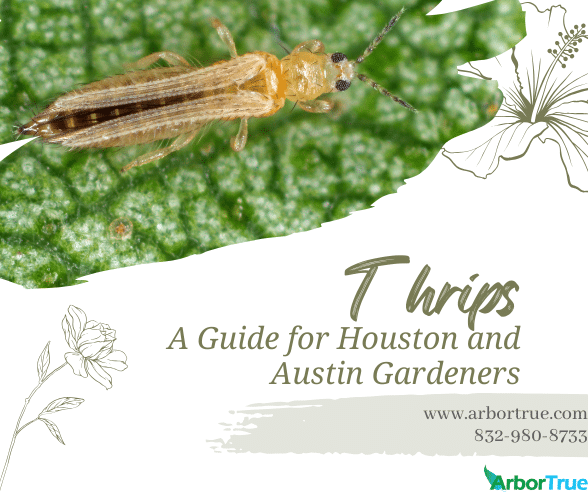
Mushroom Monday: Orange Peel Fungus (Aleuria aurantia)
August 12, 2024
Trees and Heavy Winds: The Impact and Ideas That Can Help
August 16, 2024
How to Help Trees Recover After Drought
In a recent post, we looked at some tips for helping trees through drought. In the post, we looked at the concept of drought, what stress is, and different periods of drought. When looking at helping trees through drought, we mentioned having an arborist consultation, applying mulch, proper watering, plant health care, and planting native and climate resistant trees.
In today’s post, we are going to go a little deeper and look more into the topic and also look at ideas for how to help trees recover after a drought has already happened. Read our prior post, helping trees through drought, so you can have the background information.
What are Some Drought Stress Symptoms in Trees?
There are a number of symptoms of drought that can occur in trees. Although these symptoms might be caused by other things, if your trees are experiencing drought, it could be a contributing factor.
Leaves can show a number of signs of drought. They can wilt, change color (turn yellow, look burnt, or develop browning on their edges or the tips of needles), look smaller, curl, become crispy, or fall.
The canopy overall can start to look thin, and there can be less growth of buds and twigs, and buds can form improperly.
Additionally, drought stress can cause a tree to be more susceptible to pests and diseases, and signs of these, can be an indication of this stress.
Although symptoms of drought stress can develop slowly, sometimes they can appear suddenly. A tree can look fine one week, and show signs of stress the next.
Drought Stress and Pests and Disease
When trees are experiencing drought stress, they can be more susceptible to pests and disease. There are a number of reasons for this.
One reason is that pests are generally more attracted to weakened trees than they are to healthy ones. One reason is that stressed trees release pheromones that pests can detect and are attracted to.
Additionally, a stressed tree can have damage and this can create entry points for pests and the diseases they carry.
Also, a stressed tree can be less able to defend itself against pests than a healthy one. One reason for this is that a stressed tree might be producing less sap and sap is one of the things a tree uses to defend itself against pests.
Why Does Drought Hurt Trees?
There are a number of reasons that drought hurts trees. Think of how we respond to hot conditions without enough water and you can get an idea of the negative impact of drought on trees.
Trees require water for a number of their functions and without enough they can’t function properly. Water is essential in photosynthesis, in the transport of sugars, and in the transport of other substances in a tree’s vascular system. Without enough water, everything in the tree suffers.
Drought conditions can reduce how long a tree lives and some trees might not be able to recover from a drought.
More About Stress?
We talked about stress in our previous post about drought. We mentioned that a stress on a tree basically means anything that causes the tree’s health to decline.
When a tree is experiencing drought stress it can seem like it is the only thing that is negatively impacting the tree. In reality, the tree might be experiencing multiple stresses at the same time. For example a tree might be experiencing drought and pests during the same summer.
One thing to keep in mind is that stress on a tree is cumulative. When a tree experiences stress, it causes the tree to decline. This can add up over time with other stress and can lead the tree into a mortality spiral in which it ultimately dies.
One thing to keep in mind is that because stresses are cumulative, the apparent cause of a tree’s decline or death might not be the only thing that caused it. Instead, it could be one of a number of contributing factors that combined over time to lead to the tree’s decline.
Ideas that Can Help a Tree After Drought
In our previous post, we talked about how you could help your tree through a drought. We went through a few ideas that could work together to help your tree through drought conditions. Those ideas are also beneficial for helping a tree after a drought has occurred. We’ll touch on them again below and also look at some additional steps you can take.
Idea One: Arborist Consultation
Whether during or after a drought, an arborist consultation can be a great idea for helping your trees. An arborist can evaluate the condition of your trees, see how they are responding to a drought or how they are doing after one, and help you develop a plan for their care.
Idea Two: Mulch
We’ve mentioned the benefits and importance of mulch more than once and also outlined some tips for its proper application.
In relation to mulch, one idea we’d like to mention here is the idea of grass under trees. Although grass growing under trees isn’t necessarily a bad thing, grass under a tree can compete with the tree for nutrients and water. All else being equal, a tree with grass under it will need more water than one without it.
One idea both during and after droughts that you might consider is to replace grass growing under your trees with organic, composted, mulch. Mulch, as we’ve mentioned, has a number of benefits when applied properly. An additional benefit is that it won’t compete with a tree for water the way grass does. This can help a tree both during a drought as well as after one to recover.
Idea Three: Proper Watering
Of course, watering properly is very important during a drought. We mentioned in our previous post about basing your watering on the tree, its condition, and the conditions around it. We also talked about the general idea of watering deeply and infrequently, as opposed to shallow and frequent watering. Additionally, we mentioned having your sprinkler systems inspected and adjusted and being sure to follow watering restrictions in your area.
These ideas apply during a drought but are also beneficial after one to promote the long-term health of your trees. As we mentioned, water is essential for trees and having the proper amount can be vital to their care.
In addition to the ideas we covered, some additional watering tips include:
- Watering a wide area – tree roots extend far past the drip line and you want to be sure they all get the water they need for the tree.
- Not wasting water – it can be easy to have water spray on concrete surfaces or to have it run off from where you intended because of a slope or because you are applying too much water over a short period of time. When you water, be sure and check what the water does to make sure it is getting where it is needed, and adjust things accordingly.
- Avoid watering in the middle of day when the sun is bright and temperatures are highest – during this time, water can evaporate more easily and less of it can get where it is needed.
- Avoid spraying water on tree trunks and leaves – this can promote fungal growth.
- Check the moisture in the soil – there are a number of ways to do this, from using a screwdriver and seeing how easily it goes into the top six to eight inches of soil, to devices that can test for moisture levels.
- Generally speaking, young and newly planted trees need to be watered more frequently than older established trees.
Idea Four: Plant Health Care
In our previous post, we talked about not applying fertilizers to trees if you weren’t sure what they needed, the importance of soil tests, and the value of arborist consultations. These are all important to consider both during and after a drought.
Although fertilizing during a drought might not be appropriate depending on conditions (a tree experiencing drought is stressed and fertilizers would promote growth during that time. Also, trees need sufficient moisture to be able to use fertilizers properly, and during a drought, they might not have it.), fertilizing after a drought, in the spring or fall can be beneficial for a tree. What a tree needs would depend on things like the tree, the conditions it’s in, and the nutrients it has or lacks. A soil test and an arborist consultation can help you understand the needs of your trees. Generally, you might consider organic fertilizers that release slowly as an option, along with deep root fertilization as something that can benefit your trees. Additionally, a liquid seaweed product can be beneficial for your trees during and after a drought, as well as at other times.
Another important aspect of health care for trees is dealing with pests. As we’ve mentioned, drought-stressed trees can be more negatively impacted by pests than healthy ones and pests can add a cumulative stress to them. Dealing with pests both during and after drought can be important in the long-term care of your trees and in helping them to recover from drought. Keep in mind that treating pests is something you should leave to professionals.
A third idea to consider is a product like ArborTrue Bio, that we provide. As mentioned on the ArborTrue Bio website,
“ArborTrue Bio is a unique liquid biological soil inoculant that delivers nitrogen fixing cultures and heterotrophic cultures to your plants and soils. This powerful liquid soil amendment works fantastically as a stand alone product as well as in conjunction with any granular fertilizer program to improve plant health and soil health and diversity. The proprietary cultures contained in this formula use photosynthesis and organic compounds found in the soil to fix nitrogen for plants to feed from.”
Some benefits of ArborTrue Bio include its ability to accelerate photosynthesis, improve a plant’s resistance to disease, and help improve soil biology
A product like ArborTrue Bio can be beneficial both during a drought as well as after one to help your trees to recover.
Idea Five: Planting
We mentioned in our previous post the idea of planting native and climate resistant trees as a way to have trees that can better tolerate drought. One thing to keep in mind is that you should avoid planting trees during a drought.
When a tree is planted, it stresses the tree. This stress can be compounded by drought. Generally speaking, in Texas, you should wait to plant trees until the middle of October. Then, depending on soil conditions and temperature, you can have trees planted through the middle of February.
Idea Six: Pruning
Pruning, although beneficial, can stress a tree. When a tree is pruned it is being damaged. This can compound with other stress and could harm a tree. Given this, depending on your situation, you might avoid having your trees pruned at the height of a drought. It might be better to wait until the drought is over to have this taken care of, unless there is some specific need to have a tree pruned, like removing a damaged limb.
Pruning properly after a drought can be beneficial for a tree and can help it recover. By doing things like having dead, damaged, and diseased wood removed, entry points for pests and diseases can be reduced. This can help reduce a potential additional stress that could be on the tree.
Idea Seven: Tree Removal
Not all trees make it through a drought. Some trees die as the result or from a combination of stresses. Dead trees pose a hazard and it is important to have them removed promptly. Dead trees can be a falling hazard, as can their limbs, and they can be places where pests and disease can spread. By having them removed, you can help yourself and your remaining trees after a drought.
Idea Eight: Don’t Stress Your Trees
A lot of stress on trees can be caused by us. Although generally unintentional, people can harm their trees through things like soil compaction, damage by lawn equipment, and by the application of herbicide. Take note of the condition of your trees and discuss things you might be doing with an arborist. Whether before, during, or after a drought, if you find you are doing something that is stressing your trees, change it so you can promote their health and recovery from drought.
If you found learning about how to help trees recover after drought useful, check out the other posts on our TrueTreeTalk blog. Also, follow us on Facebook to keep up with these and other posts.
* * *
ArborTrue is a science-based tree-service company in the greater Houston area. We also serve Austin and other parts of Central Texas. We provide a range of services including tree trimming, tree pruning, tree removal, tree planting, arborist consultations, and more. Call us today at 832-980-8733 (Houston) or at 512-546-3833 (Austin) or reach out to us online to schedule an appointment.




